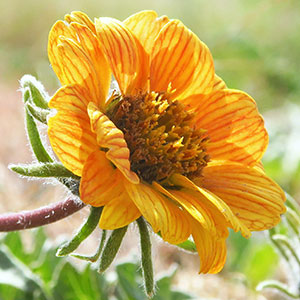Balsamorhiza rosea
Balsamorhiza serrata
rosy balsamroot
serrate balsam root, serrated balsamroot, serrrate balsamroot, tooth balsamroot
blades gray-green, oblong to lance-ovate, 3–10(–20) × 2–5 cm (rarely pinnately lobed), bases weakly cordate or truncate, margins crenate to serrate, apices rounded to acute, faces finely strigose to moderately scabrous (usually gland-dotted as well).
blades pale green to gray-green, lanceolate or lance-ovate, 5–15(–20+) × 2–5(–10) cm (earliest sometimes, later seldom, pinnately lobed, mostly toward tips), bases usually cuneate to subtruncate, sometimes cordate, margins usually dentate to serrate, apices acute, faces hirsutulous to scabrous.
hemispheric, 18–20 mm diam.
campanulate, 15–25 mm diam.
(becoming brick-red, often drying to pink or rose, and chartaceous) (8–)15(–25) mm (hispidulous abaxially; cypselae strigose).
(20–)30–40.
deltate or ovate to lanceolate, 8–12 mm, not surpassing inner.
lanceolate to lance-triangular, 10–22 mm, shorter than inner, apices acute to attenuate (margins ciliate).
usually borne singly.
usually borne singly.
= 38.
= 38.
Balsamorhiza rosea
Balsamorhiza serrata
In a hybrid swarm involving Balsamorhiza rosea and B. careyana, B. rosea remains relatively uncontaminated; the dominance among the hybrids appears to lie with B. careyana. A record of a hybrid between B. rosea and B. careyana from the Spokane area is doubtful.
(Discussion copyrighted by Flora of North America; reprinted with permission.)
Balsamorhiza serrata hybridizes with B. careyana. Leaves of the hybrids tend to be prostrate rather than erect. Most of the hybrids display the larger size of B. careyana and lack the pubescence of the heads; serrata-like plants never develop more than a single head nor do they have the pubescence of the cypselae.
(Discussion copyrighted by Flora of North America; reprinted with permission.)


